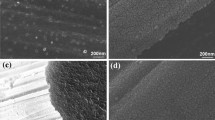Abstract
Solution phase synthesis of intermetallic nanoparticles without using surfactants (for catalytic applications) and subsequent control of size distribution remains a challenge: of growing interest, but not widely explored yet. To understand the questions in the syntheses of Pt containing intermetallic nanoparticles (as electrocatalysts for direct fuel cells) by using sodium naphthalide as the reducing agent, the effects of the Pt precursors’ organic ligands were investigated. PtPb syntheses were studied as the model case. In particular, methods that lead to nanoparticles that are independent single crystals are desirable. Platinum acetylacetonate, which is soluble in many organic solvents, has ligands that may interfere less with nanoparticle growth and ordering. Interesting trends, contrary to expectations, were observed when precursors were injected into a reducing agent solution at high temperatures. The presence of acetylacetonate, from the precursor, on the nanoparticles was confirmed by ATR, while SEM imaging showed evidence of morphological changes in the nanoparticles with increasing reaction temperature. A definite relationship between domain size and extent of observed residue (organic material and sodium) present on the particles could be established. By varying post-reaction solvent removal techniques, room temperature crystallization of PtPb nanoparticles was also achieved. Electrochemical activity of the nanoparticles was also much higher than that of nanoparticles synthesized by previous reaction schemes using sodium naphthalide as the reducing agent. Along with the above mentioned techniques, BET, TEM, CBED, SAED, and XRD were used as characterization tools for the prepared nanoparticles.
















Similar content being viewed by others
References
Alden LR, Han DK, Matsumoto F, Abruña HD, DiSalvo FJ (2006a) Intermetallic PtPb nanoparticles prepared by sodium naphthalide reduction of organometallic precursors: electrocatalytic oxidation of formic acid. Chem Mater 18:5591–5596
Alden LR, Roychowdhury C, Matsumoto F, Han DK, Zeldovich V, Abruña HD, DiSalvo FJ (2006b) Synthesis, characterization and electrocatalytic activity of PtPb nanoparticles prepared by two synthetic approaches. Langmuir 22:10465–10471
Basato M (2003) Reaction of platinum acetate with phosphines and molecular structure of trans-[Pt(OAc)2(PPh3)2]. Inorgánica Chimica Acta 355:399–403
Blasini DR, Rochefort D, Fachini E, Alden LR, DiSalvo FJ, Cabrera CR, Abruña HD (2006) Surface composition of ordered intermetallic compounds PtBi and PtPb. Surf Sci 600:2670–2680
Casado-Rivera E, Gál Z, Angelo ACD, Lind C, DiSalvo FJ, Abruña HD (2003) Electrocatalytic oxidation of formic acid at an ordered intermetallic PtBi surface. Chem Phys Chem 4:193–199
Casado-Rivera E, Volpe DJ, Alden L, Lind C, Downie C, Vázquez-Alvarez T, Angelo ACD, DiSalvo FJ, Abruña HD (2004) Electrocatalytic activity of ordered intermetallic phases for fuel cell applications. J Am Chem Soc 126:4043–4049
Keller RN (1946) Inorganic syntheses, vol 2. McGraw-Hill Book Co, New York, p 247
Lamy CL, Srinivasan S (2001) Direct methanol fuel cells: from a twentieth century electrochemist’s dream to a twenty-first century emerging technology, vol 34. Kluwer Academic/Plenum Publishers, New York
Liu H, Song C, Zhang L, Zhang J, Wang H, Wilkinson DP (2006) A review of anode catalysis in direct methanol fuel cell. J Power Sources 155:95–110
Matsumoto F, Roychowdhury C, DiSavlo FJ, Abruña HD (2008) Electrocatalytic activity of ordered intermetallic PtPb nanoparticles prepared by borohydride reduction toward formic acid oxidation. J Electrochem Soc 155(2):B148–B154
Mortimer CT (1984) Platinum-ligand and palladium-ligand bond energies. Rev Inorg Chem 6(3):233–257
Murugan NA, Yasonath S (2005) Pressure induced orientational ordering in p-Terphenyl. J Phys Chem B 109:1433–1440
Oana M, Hoffmann R, Abruña HD, DiSalvo FJ (2005) Adsorption of CO on PtBi2 and PtBi surfaces. Surf Sci 574:1–16
Prabhuram J, Zhao TS, Tang ZK, Chen R, Liang ZX (2006) Multi-walled carbon nanotubes supported PtRu for the anode of direct methanol fuel cells. J Phys Chem B 110:5245–5252
Roychowdhury C, Matsumoto F, Mutolo PF, Abruña HD, DiSalvo FJ (2005) Synthesis, characterization and electrocatalytic activity of PtBi nanoparticles prepared by the polyol process. Chem Mater 17:5871–5876
Roychowdhury C, Matsumoto F, Zeldovich VB, Warren SC, Mutolo PF, Ballesteros M, Weisner U, Abruña HD, DiSalvo FJ (2006) Synthesis, characterization, and electrocatalytic activity of PtBi and PtPb nanoparticles prepared by borohydride reduction in methanol. Chem Mater 18:3365–3372
Shah RK, Kandlikar SJ (2003) Fuel cell science, engineering and technology. American Society of Mechanical Engineers, New York
Volpe D, Casado-Rivera E, Alden L, Lind C, Hagerdon K, Downie C, Korzeniewski C, DiSalvo FJ, Abruña HD (2004) Surface treatment effects on the eElectrocatalytic activity and characterization of intermetallic phases. J Electrochem Soc 151:A971–A977
Warren BE (1990) X-ray Diffraction, 1st edn. Dover Publications Inc, NY, USA
Acknowledgments
This study was supported by the Basic Energy Sciences Division of the Department of Energy through Grants: DE-FG02-03ER46072 and DE-FG02-87ER4529. The authors thank Mick Thomas for help with the UHV-STEM data, John Hunt for the EPMA microprobe and John Grazul for the TEM data for which we made use of the UHV- STEM, TEM, and EPMA microprobe, laboratories of Cornell Center for Materials Research (CCMR). The BET surface area for the PtPb samples was measured in Prof. Ulrich Wiesner’s laboratory in the department of Materials Science and Engineering, at Cornell University. The BET surface area of one of the PtPb compounds (series 1, 120 °C reaction) was measured at Primet Precision Materials Inc. in Ithaca, NY. The authors would also like to thank Thomas McCarrick and Prof. J. Meinwald for helpful discussions on IR spectra.
Author information
Authors and Affiliations
Corresponding author
Rights and permissions
About this article
Cite this article
Ghosh, T., Matsumoto, F., McInnis, J. et al. PtPb nanoparticle electrocatalysts: control of activity through synthetic methods. J Nanopart Res 11, 965–980 (2009). https://doi.org/10.1007/s11051-008-9557-y
Received:
Accepted:
Published:
Issue Date:
DOI: https://doi.org/10.1007/s11051-008-9557-y




